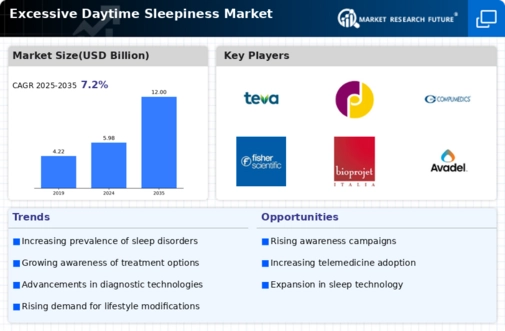Market Growth Projections
The Global Excessive Daytime Sleepiness Market Industry is poised for substantial growth, with projections indicating a market value of 5.98 USD Billion in 2024 and an anticipated increase to 12.0 USD Billion by 2035. This growth trajectory suggests a compound annual growth rate (CAGR) of 6.52% from 2025 to 2035. Such figures reflect the increasing recognition of excessive daytime sleepiness as a critical health issue, prompting investments in research and development of effective treatments and technologies. Stakeholders in the industry are likely to capitalize on this growth by innovating and expanding their offerings to meet the evolving needs of consumers.
Impact of Lifestyle Changes
Modern lifestyle changes, including increased stress levels and sedentary behavior, are contributing to the rise of excessive daytime sleepiness, thus impacting the Global Excessive Daytime Sleepiness Market Industry. Factors such as long working hours, poor dietary habits, and lack of physical activity are leading to sleep disturbances. As more individuals recognize the link between lifestyle choices and sleep quality, there is a growing demand for interventions aimed at improving sleep hygiene. This trend is likely to drive market growth, as consumers seek effective solutions to combat the adverse effects of their lifestyles on sleep.
Aging Population and Sleep Needs
The aging demographic is a significant factor driving the Global Excessive Daytime Sleepiness Market Industry. As the global population ages, the prevalence of sleep disorders tends to increase, leading to higher instances of excessive daytime sleepiness. Older adults often experience changes in sleep patterns and are more susceptible to conditions that disrupt sleep. This demographic shift necessitates tailored solutions to address their unique sleep needs. With the market expected to grow substantially, the aging population presents both challenges and opportunities for stakeholders in the sleep health sector.
Increased Awareness of Sleep Health
There is a growing recognition of the importance of sleep health among the global population, which serves as a catalyst for the Global Excessive Daytime Sleepiness Market Industry. Public health campaigns and educational initiatives are raising awareness about the detrimental effects of sleep deprivation and excessive daytime sleepiness. This heightened awareness is leading to increased demand for diagnostic tools and treatment options. As individuals become more informed about the consequences of poor sleep, they are more likely to seek medical advice and interventions, thereby propelling market growth. The anticipated CAGR of 6.52% from 2025 to 2035 underscores the potential for sustained expansion in this sector.
Rising Prevalence of Sleep Disorders
The increasing incidence of sleep disorders globally is a primary driver of the Global Excessive Daytime Sleepiness Market Industry. Conditions such as obstructive sleep apnea and narcolepsy are becoming more prevalent, affecting millions worldwide. For instance, it is estimated that around 22 million Americans suffer from sleep apnea alone. This growing awareness and diagnosis of sleep-related issues contribute to the market's expansion, as more individuals seek treatment options. The Global Excessive Daytime Sleepiness Market is projected to reach 5.98 USD Billion in 2024, reflecting the urgent need for effective solutions to combat excessive daytime sleepiness.
Technological Advancements in Sleep Aids
Innovations in sleep technology are significantly influencing the Global Excessive Daytime Sleepiness Market Industry. The development of wearable devices and mobile applications that monitor sleep patterns and provide personalized recommendations is gaining traction. These advancements not only enhance the quality of sleep but also empower users to manage their sleep health proactively. For example, smartwatches equipped with sleep tracking features are becoming increasingly popular. As these technologies evolve, they are likely to drive market growth, with projections indicating a market value of 12.0 USD Billion by 2035, highlighting the potential for continued innovation in sleep management.









